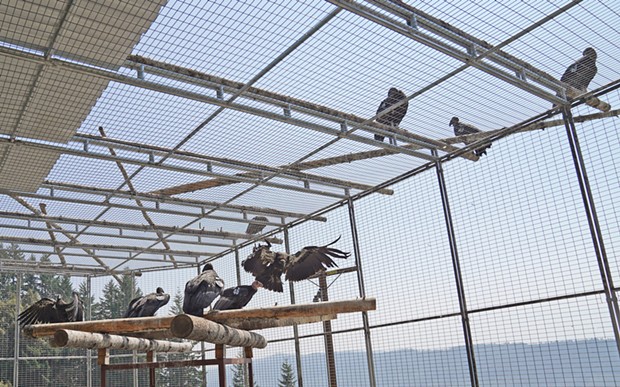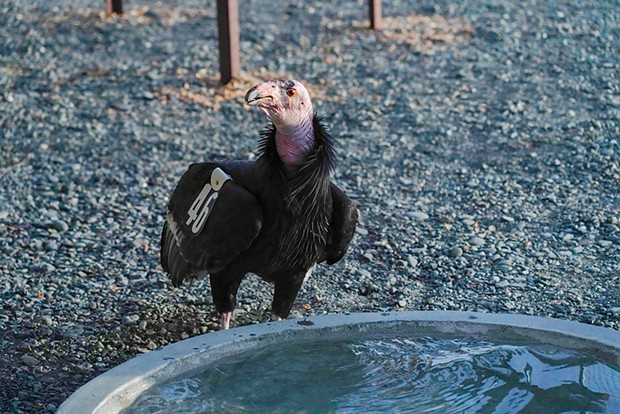News Blog
Mentor Condor 746 Being Moved Due to Bird Flu Concerns

- Courtesy of the Yurok Tribe
- Members of the first cohort sit on top of the enclosure with the new cohort and mentor bird No. 746 inside.
The first California condor in more than a century to land on the North Coast arrived by plane March 25 from an Idaho breeding facility.
For nearly a year, the 7-year-old male known as No. 746 — with the nickname Paaytoqin, which in Nez Perce means “come back” — has helped raise the eight condors now flying free in the region as part of a Yurok Tribe-led effort to return the endangered bird they know as prey-go-neesh to its former territory.
In an interview with the Journal earlier this year, Yurok Tribe Wildlife Department Director Tiana Williams-Claussen, who worked most of her adult life to bring the condor back, said his arrival was profound in ways that even surprised her. 
"I think we'd all been looking forward to this day, this event when we bring up these birds that would eventually be released, but it was this mentor bird who first hit me really hard," she said. "He's just a visitor with us, he's not going to be released because he's actually got really important genetics, so he's going to be going back to one of the breeding facilities to contribute once he's done teaching our young whippersnappers how to be down here, but he was literally the first condor to be in Yurok country for over 130 years, which just really struck me."
Since captive-raised condors — like those in the current North Coast cohort — don’t get to spend as much time learning from their parents as they would in the wild, so-called mentor condors like No. 746 are brought in before their release to teach the younger birds how to be condors, imparting important lessons on what it means to live in a highly social and hierarchical flock.
But the spread of avian flu — which has high mortality rates — has shortened his stay, according to a recent announcement from the Northern California Condor Restoration Program, which described No. 746 as “a shining social and behavioral example and tutor for the young condors in our new population.”
“Recently, cases of dead birds testing positive for H5N1 within our local region have sharply increased,” the NCCRP note states. “The free-flying NCCRP condors are considered wild birds and will not be trapped to protect them from potential diseases. Condor 746, despite being a captive bird, is still exposed to risks in the natural environment through the open-air walls of the NCCRP flight pen. As a captive individual under NCCRP’s care, we would be negligent if every attempt was not made to protect 746 from potential health risks.”
The current plan is to move mentor to the Oakland Zoo to reduce his chance of exposure, with the possibility of returning at a future date.
“Although we wish that every condor could have the opportunity to fly free, 746 still has a very important role to play in the larger plan of saving this species from extinction,” the announcement states. “With prime genetics, 746 has the potential to contribute greatly to the captive breeding program and benefit populations at all California condor reintroduction sites. We’re incredibly grateful for the many captive breeders, like 746, without which this amazing species would have long ago been lost from our skies forever.”
Find out more about the NCCRP program and watch the condors on live stream here.
For nearly a year, the 7-year-old male known as No. 746 — with the nickname Paaytoqin, which in Nez Perce means “come back” — has helped raise the eight condors now flying free in the region as part of a Yurok Tribe-led effort to return the endangered bird they know as prey-go-neesh to its former territory.
In an interview with the Journal earlier this year, Yurok Tribe Wildlife Department Director Tiana Williams-Claussen, who worked most of her adult life to bring the condor back, said his arrival was profound in ways that even surprised her.

- Photo courtesy of Matt Mais/Yurok Tribe
- Mentor bird No. 746 has the job of teaching the young condors important life skills to help them thrive in the wild.
"I think we'd all been looking forward to this day, this event when we bring up these birds that would eventually be released, but it was this mentor bird who first hit me really hard," she said. "He's just a visitor with us, he's not going to be released because he's actually got really important genetics, so he's going to be going back to one of the breeding facilities to contribute once he's done teaching our young whippersnappers how to be down here, but he was literally the first condor to be in Yurok country for over 130 years, which just really struck me."
Since captive-raised condors — like those in the current North Coast cohort — don’t get to spend as much time learning from their parents as they would in the wild, so-called mentor condors like No. 746 are brought in before their release to teach the younger birds how to be condors, imparting important lessons on what it means to live in a highly social and hierarchical flock.
But the spread of avian flu — which has high mortality rates — has shortened his stay, according to a recent announcement from the Northern California Condor Restoration Program, which described No. 746 as “a shining social and behavioral example and tutor for the young condors in our new population.”
“Recently, cases of dead birds testing positive for H5N1 within our local region have sharply increased,” the NCCRP note states. “The free-flying NCCRP condors are considered wild birds and will not be trapped to protect them from potential diseases. Condor 746, despite being a captive bird, is still exposed to risks in the natural environment through the open-air walls of the NCCRP flight pen. As a captive individual under NCCRP’s care, we would be negligent if every attempt was not made to protect 746 from potential health risks.”
The current plan is to move mentor to the Oakland Zoo to reduce his chance of exposure, with the possibility of returning at a future date.
“Although we wish that every condor could have the opportunity to fly free, 746 still has a very important role to play in the larger plan of saving this species from extinction,” the announcement states. “With prime genetics, 746 has the potential to contribute greatly to the captive breeding program and benefit populations at all California condor reintroduction sites. We’re incredibly grateful for the many captive breeders, like 746, without which this amazing species would have long ago been lost from our skies forever.”
Find out more about the NCCRP program and watch the condors on live stream here.
Comments